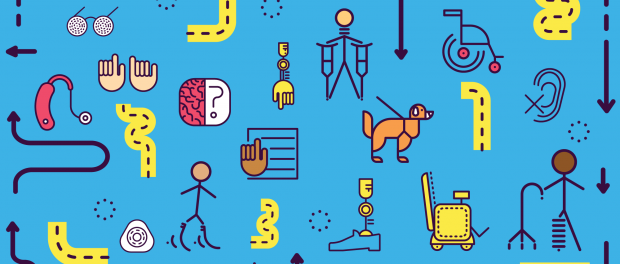Accessing the world around us

Accessing the world around us, for the majority of people, is intuitive, automatic—not something one would have to consciously think about or navigate. As someone who loves the art of people watching I have always found it fascinating to watch those who are naturally savvy in how they access the world. It has always made me feel like an outsider, and at times, envious. I am in the minority because I have to actively work at accessing the world around me. I am one of 22 per cent of Canadians who live with a permanent disability.
I grew up with amazing parents who taught me that I am as deserving as everyone around me to the fullness of society, activities, hobbies, etc. At the same they were often my best advocates, teaching me how to effectively access accommodations to level the field. I remember my mom, in numerous parent-teacher interviews, explaining that the ‘behaviours’ the teacher were seeing were from a child who is hard-of-hearing rather than a child wilfully acting out.
As an adult I developed additional disabilities, which came with additional challenges—especially in the world of work. I have learned that physical barriers are far more plentiful than I had known about when growing up. I’ve learned the frustrations of travelling by myself while accessing a wheelchair in airports, of navigating a grocery store with a heavy cart while using a cane, of people addressing my husband or a friend, assuming they are my support person, instead of conversing with me. I’ve also run the gamut of people’s reactions from asking probing questions to making assumptions that it’s a transient condition. I’m also, unfortunately, used to not being able to fully follow conversations, especially in groups or noisy environments. Until your access to the innate world around you changes, it can often be difficult to see the barriers that exist. Dealing with them on a daily basis can be very draining on a person.
One of the ways that some social barriers are beginning to be reduced has been the availability of emojis that are inclusive of certain disabilities. More recently I’ve been able to create my own stickers, very much like bitmojis, and include things like my hearing aids. There are also organizations working toward the reduction of barriers. The Rick Hansen Foundation, for example, has launched a really interesting ad campaign on television. I like the simplicity of its message—#EveryoneEverywhere. It’s a campaign for improving physical access to all spaces in Canada for people of all abilities. As the campaign points out, barriers to physical access denies people full access to society. Read more about this campaign.
With the onset of the COVID-19 pandemic there has been a societal shift in how we all access our world. Suddenly we’ve been asked to stay at home, work from home where possible, distance ourselves physically from others when outside of our home, and wear a mask if we are concerned when in public. We are inundated with a 24-hour news cycle that is full of statistical updates, press conferences, and a myriad of experts providing opinions. Here’s the interesting question—has anyone stopped to think about the ripple effect of this on the Disability Community?
I do not profess to be an expert on all aspects of this topic, rather these observations and thoughts are my own from my experience and my own musings.
I know that some of the accommodations I utilize in my work environment can be adapted to work at home, while others are much more difficult. For example, I utilize an FM system during staff meetings to enhance my ability to follow the meeting. Moving to a digital platform where I lose the ability to ‘see’ the speaker means I struggle to follow parts of the meeting, especially if the audio is bad. In addition, many digital platforms either do not offer a live captioning service, or people running the meetings don’t know it exists or how to enable it. Today the problem is aggravated, as one of my hearing aids has decided to stop working properly, and I have no access to the clinic or a technician as they are closed—they’re not an essential service. I know that these meetings are frustrating to many of my hearing colleagues, I can only imagine how my hard-of-hearing or deafened colleagues feel!
I’m sure many of you have noticed that press conferences are featuring ASL interpreters, which is a fantastic step in ensuring that people whose first language is sign language can, in real time, find out stay on top of important events and developments. I was ecstatic to see this, especially at all levels of the government across the country. Closed captioning is still English, which is not the first language of many in the deaf community. In addition, closed captioning only works if the words are allowed to remain on the screen, and more often than not they are cut off when the news cycles between one story and the next.
The world has rapidly shifted over the past three months—how we keep ourselves up-to-date is important. How we access accommodations at work is also shifting rapidly. Working together as members of OSSTF/FEESO, alongside our employers, perhaps we can ensure that those in the Disability Community are included in discussions around the new working conditions. After all, as the South African disability rights movement reminds us, “nothing about us, without us, is for us.”



Excellent …..so proud of you